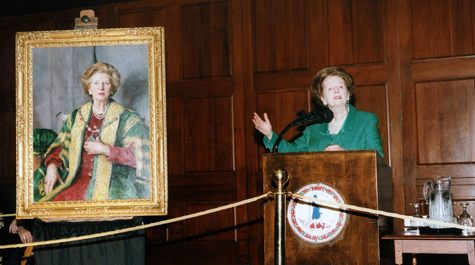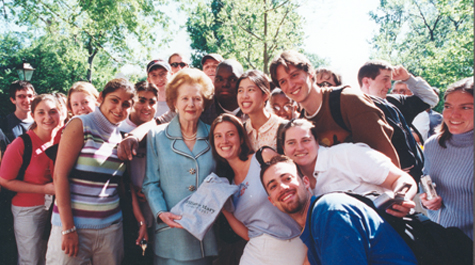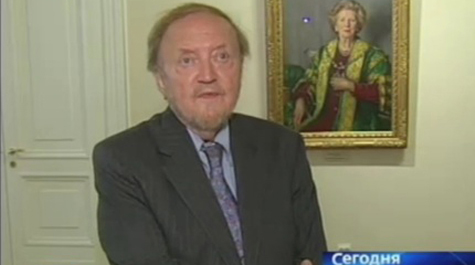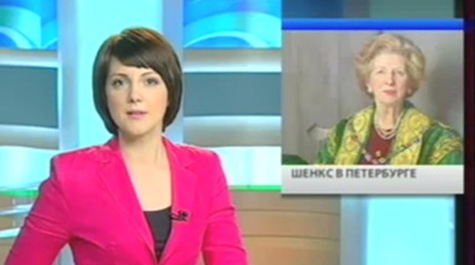The portrait of the 'Iron Lady' returns
Now, that portrait of the “Iron Lady” has returned to the College’s Sir Christopher Wren Building after travelling to Russia.
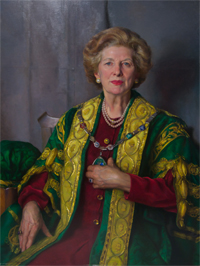 The oil on canvas painting by esteemed American portrait painter Nelson Shanks was displayed at the State Russian Museum in St. Petersburg from last June to July, as well as at the Russian Academy of the Arts from July to October.
The oil on canvas painting by esteemed American portrait painter Nelson Shanks was displayed at the State Russian Museum in St. Petersburg from last June to July, as well as at the Russian Academy of the Arts from July to October.The exhibition, which featured a number of works by Shanks, was organized by the Foundation for International Arts and Education. This organization, Melissa Parris, registrar at the Muscarelle Museum of Art explained, “helps to protect and preserve the historical and cultural legacy of the countries of the former Soviet Union” through arts and exhibition programs.
“I think this is a pretty historic and important exhibition,” Parris said. ”I don’t think there’s often a solo artist show that’s in such prominent Russian museums, so in that way it’s important for the artist and for showing American art in another country. But also, for us, the College is represented all the way in Russia. I think that it’s really particularly important that in this portrait as she’s wearing the William & Mary Chancellor’s robe.”
While other objects from the museum collection have been loaned overseas before, it is the first time there has been a loan to Russia.
The Story Behind the Portrait
The portrait of Thatcher was commissioned by the College of William & Mary in 1998 and purchased with the support of alumnus J. Bruce Bredin ’36. At the time, Thatcher, who served as the College’s Chancellor from 1993 to 2000, was a familiar face on campus.
“She went to Richmond on our behalf,” recalled Louise Kale, director of the Historic Campus. “She lent herself to fundraising appeals. She was a real presence at William and Mary, especially when you compare her to the Colonial chancellors or to George Washington, who agreed to accept the office of Chancellor only after being reassured that he would not have to travel to Williamsburg. The College – everybody at the College – related to her in a personal way.”
Kale was present when the artist, Shanks, initially visited William & Mary to discuss the portrait.
“He came to the Wren Building to choose the wall in the Blue Room where the portrait would hang,” Kale said. “So, the portrait was actually painted specifically for the Blue Room and specifically for the wall where the portrait is displayed today.”
Also displayed in the Blue Room are portraits of the College’s first Chancellor, Henry Compton, the Bishop of London, and George Washington, the College’s first American Chancellor as well as the nascent nation’s first president.
After seeing where the portrait would be displayed, Shanks purchased an antique carved wood and gilded frame especially for the portrait.
“The artist was so invested in how this portrait was going to look in the setting for which it was painted,” Kale said.
During that first meeting, Kale was asked to model the Chancellor’s robe.
“The robe stands for the office, and I remember Mr. Shanks’ enthusiasm when he first saw it,” Kale said. “He was very interested in rendering that robe.”
The Chancellor’s regalia featured in the portrait was designed in 1993, the College’s 300th anniversary, and first worn by Thatcher. The robe is made of green silk damask and decorated by gold oak leaf lace and gold ornaments.
The completed portrait was unveiled on Charter Day in 2000. The dedication ceremony was held in the Blue Room on the last day of classes in April 2001. During the ceremony, Thatcher was made an honorary member of the class of 2001.
Kale clearly recalls that day, when, after the ceremony, Thatcher became the first member of the class to ring the bell. Kale was standing on the balcony of the Wren building, looking out on the College Yard.
“There was a substantial group of seniors, probably between 50 and 100, out at the bottom of the front steps,” Kale said. “She went down the center steps [of the building] and walked down the front steps to go to the President’s House, and she just walked right into the middle of that group of students and you saw this tiny lady completely surrounded by these very enthusiastic seniors welcoming her to that class.”
The newly dedicated portrait, like its subject, “came and went,” in Kale’s words. In 2002, the portrait was taken to Palm Beach, Fla., for an exhibition of Shanks’ works. In 2004 and 2006, it traveled to Philadelphia, again, as part of exhibitions displaying his paintings.
“Nelson Shanks really likes to be represented by that portrait because it is spectacular,” Kale said.
Parris, too, noted the beauty of the portrait, which is the latter of two portraits of Thatcher painted by Shanks.
“It’s got such a jewel-like quality that you don’t really see in the digital images or the published image of it,” Parris said.
During a shuffle of portraits in 2009, the portrait was moved from the Blue Room to the board room in Blow Hall where the Board of Visitors meet.
Preparing for the Journey
The following year, the Muscarelle Museum of Art was approached by the Foundation for International Arts and Education. As the museum’s registrar, Parris handled the “nuts and bolts” to prepare for the portrait’s journey.
“The first letter we received was March 2010 and that was their initial request for a loan,” Parris said.
In the following months, Parris reviewed all their facility reports and the organization’s fine arts insurance policy.
“I had quite a lot of questions about the Russian venues,” Parris said. “That took a lot of time because we had translations from Russian to English and then I would read the English version. There were just a lot of questions in the way that they would word things, so I would have to get a lot of clarification on what exactly they meant.”
Issues that had to be addressed included environmental conditions and climate control among other things.
“I asked them to send me a floor plan of what the museum looks like and then I said ‘Could you show me where in the floor plan it’s going to be exhibited,’” Parris said. “We really have to make sure that its placement isn’t going to affect it either aesthetically because it’s in some weird niche, but also so that the climate control can be maintained and it’s not getting excess heat and dryness from any heat source.”
The next step was to actually prepare the portrait for the journey, which involved creating a microclimate frame and a crate.
To create a microclimate frame, Parris explained, “We built out the existing frame so that we could put a piece of Plexiglas glazing in front of it.”
This protects the painting from too many fluctuations in temperature and humidity levels. The crate was custom-built by a fine arts company to meet both the museum’s specifications and international shipping standards.
Once the portrait began its journey, an appointed courier monitored its transit.
“Usually, what a courier does is they watch it go from truck to the aircraft and then the aircraft to the next truck to the museum all the way through to opening the crate and making sure that everything is handled properly,” Parris said.
To Russia and Back
Finally, on June 2, 2011, the portrait of Margaret, the Lady Thatcher, was exhibited at the State Russian Museum in St. Petersburg, the first state museum in Russia. The exhibition, named “Nelson Shanks in Russia,” featured 50 pieces by Shanks, including portraits of American presidents Bill Clinton and Ronald Reagan, Pope John Paul II, and Lady Diana, Princess of Wales. The exhibition was in St. Petersburg until July 18, 2011.
A few days later, the exhibition was moved to the Russian Academy of Arts in Moscow, where the portraits were exhibited from July 28 to Oct. 9, 2011.
Shanks himself traveled to Russia for these exhibitions, teaching a master class at the Russian Academy of the Arts in Moscow. He was also featured in Russian media, being interviewed with the portrait of Thatcher in her green and gold robes over his shoulder.
When the exhibitions were completed, the portrait of Thatcher returned home, arriving at the end of last semester. Since another portrait had replaced it in the board room at Blow Hall, the portrait is back where Shanks had envisioned it, across from former College Chancellors George Washington and Henry Compton.
“She’s a real presence in the Wren building—both the subject and the portrait,” Kale said. “Our visitors and students seem to have a personal reaction to this portrait, and I think that says something about the sitter, and it also says something about the artist.”
Kale added, “I hope they’re going to let her rest for while now.”
 Skip to main content
Skip to main content


